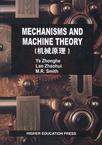机械原理
2001-7
高等教育出版社
叶仲和,蓝兆辉,(英)史密斯(M.R.Smith) 编
247
380000
本书是根据国家教育部制订的“高等工业学校机械原理课程教学基本要求”并结合作者多年教学和科研的成果而编写的。本书以培养学生基本设计能力和创新设计能力为目标,强化解析法和机构综合内容,反映了机构学的新成果和发展趋势。全书共十二章,包括绪论、平面机构结构分析、机械运动分析、平面连杆机构、凸轮机构、齿轮机构、轮系、其它常用机构、组合机构、机械平衡、机械系统的运转及其调速、机构系统创新设计。大部分章节均附有相当数量的思考题和练习题。为方便中国学生阅读,书末附有英中词汇对照表。 本书可作为高等工科院校本科机械类专业学生学习机械原理课程的教材及专业英语教材,也可供有关教师、学生及工程技术人员参考。
作者:叶仲和 蓝兆辉 (英国)史密斯(M.R.Smith)
Chapter1 Introduction 1.1 Study Object 1.2 Study Content 1.3 PurposeChapter2 Structural Analysis of Pianar Mechanims 2.1 Planar Kinematic Pairs and Planar Mechanisms 2.2 The Kinematic Diagram of a Mechanism 2.3 Degree of Freedom of a Mechanism 2.4 Points for Attention during the Calculation of DOF 2.5 The Composition Principle and Structural Analysis Problems and ExercisesChapter3 Kinematic Analysis of Mechanisms 3.1 Tasks and Methods of Kinematic Analysis 3.2 Velocity Analysis by the Method of Instant Centres 3.3 Kinematic Analysis by Analytical Methods Problems and ExercisesChapter4 Planar Linkage Mechanisms 4.1 Characteristics of Planar Linkage Mechanisms 4.2 The Types of Four-bar Linkages 4.3 Characteristics Analysis of Fou-bar Linkages 4.4 Dimensional Synthesis of Four-bar Linkages Problems and ExercisesChapter5 Cam Mechanisms 5.1 Characteristics and Classification of Cam Mechanisms 5.2 Follower Motion Curves 5.3 Plate Cam with Translating Roller(or Knife-edge)Follower 5.4 Plate Cam with Oscilating Roller Follower 5.5 Plate Cam with Translating Flat-faced Follower 5.6 Plate Cam with Oscillating Flat-faced Follower Problems and ExercisesChapter6 Gear Mechanisms 6.1 Types of Gear Mechanisms 6.2 Fundamentals of Engangement of Tooth Profiles 6.3 The Involute and Its Properties 6.4 Standard Involute Spur Gears 6.5 Gearing of Involute Spur Gears 6.6 Contact Ratio of an Involute Spur Gears Set 6.7 Manufacturing Methsds of Involute Profiles 6.8 Addendum Modification on Involute Spur Gears 6.9 Helical Gears for Parallel Shafts 6.10 Worm Gearing 6.11 Bevel Gears Problems and ExercisesChapter7 Gear TrainsChapter8 Other Mechanisms in Common UseChapter9 Combined MechanismsChapter10 Balancing of MachineryChapter11 Motion of Mechanical Systems and its RegulationChapter12 Creative Design of Mechanism SystemsVocabularyReferences前言
版权页:插图:(1) Choose the kinematic chain to be as short as possible A shorter kinematic chain here means fewer links and kinematic pairs. This can reduce thecost of manufacture and the kinematic error. Efficiency can also be increased. (2) Use the mechanism with higher efficiency The efficiency of a kinematic chain is the product of the efficiencies of the componentmechanisms if they are connected in series. Therefore, the kinematic chain transmitting themain power should not include a mechanism with lower efficiency. (3) Arrange the mechanisms in proper order Generally, the speed of working links are lower than the others and variable. Therefore,the mechanisms which convert the forms of motion (e. g. cam mechanisms and linkage mech-anisms) are placed at the end of the kinematic chain, i. e. near the working link. In thisway, the vibration of the mechanism can be reduced. In addition, the frictional transmittingmechanisms such as belt drives should be arranged near the motors where the speed is higherand the torque is lower. Such an arrangement can reduce the size of the driving system withoverload protection and the prime mover can be located with more flexibility. (4) Choose reasonable transmission ratios Every mechanism should work within its applicable range of transmission ratio to ensureproper performance. Furthermore, careful choice of the transmission ratios can considerablyreduce the size of the system. Obviously, the above hints can also be used in selection of the mechanisms or rough initialevaluation of the mechanism system.
《机械原理》为高等工科院校本科机械类专业系列丛书之一。

对于一本英文“机械原理”应该来说很不错了,内容翔实,而且价格绝对实惠,性价比不错!---我推荐!